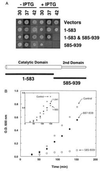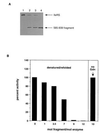Dominant negative inhibition by fragments of a monomeric enzyme
- PMID: 8962072
- PMCID: PMC26153
- DOI: 10.1073/pnas.93.25.14452
Dominant negative inhibition by fragments of a monomeric enzyme
Abstract
Dominant negative inhibition is most commonly seen when a mutant subunit of a multisubunit protein is coexpressed with the wild-type protein so that assembly of a functional oligomer is impaired. By analogy, it should be possible to interfere with the functional assembly of a monomeric enzyme by interfering with the folding pathway. Experiments in vitro by others suggested that fragments of a monomeric enzyme might be exploited for this purpose. We report here dominant negative inhibition of bacterial cell growth by expression of fragments of a tRNA synthetase. Inhibition is fragment-specific, as not all fragments cause inhibition. An inhibitory fragment characterized in more detail forms a specific complex with the intact enzyme in vivo, leading to enzyme inactivation. This fragment also associated stoichiometrically with the full-length enzyme in vitro after denaturation and refolding, and the resulting complex was catalytically inactive. Inhibition therefore appears to arise from an interruption in the folding pathway of the wild-type enzyme, thus suggesting a new strategy to design dominant negative inhibitors of monomeric enzymes.
Figures




Similar articles
-
Autonomous folding of a C-terminal inhibitory fragment of Escherichia coli isoleucine-tRNA synthetase.Biochim Biophys Acta. 1999 Aug 17;1433(1-2):103-9. doi: 10.1016/s0167-4838(99)00153-3. Biochim Biophys Acta. 1999. PMID: 10446363
-
Control of arginine biosynthesis in Escherichia coli: role of arginyl-transfer ribonucleic acid synthetase in repression.J Bacteriol. 1973 Mar;113(3):1419-32. doi: 10.1128/jb.113.3.1419-1432.1973. J Bacteriol. 1973. PMID: 4570785 Free PMC article.
-
Misaminoacylation by glutaminyl-tRNA synthetase: relaxed specificity in wild-type and mutant enzymes.Fed Proc. 1984 Dec;43(15):2972-6. Fed Proc. 1984. PMID: 6389180
-
Enhanced level and metabolic regulation of methionyl-transfer ribonucleic acid synthetase in different strains of Escherichia coli K-12.J Bacteriol. 1975 Aug;123(2):580-8. doi: 10.1128/jb.123.2.580-588.1975. J Bacteriol. 1975. PMID: 1097418 Free PMC article.
-
Glutaminyl-tRNA synthetase: from genetics to molecular recognition.Genes Cells. 1996 May;1(5):421-7. doi: 10.1046/j.1365-2443.1996.d01-255.x. Genes Cells. 1996. PMID: 9078373 Review.
Cited by
-
Oligomerization domain-directed reassembly of active dihydrofolate reductase from rationally designed fragments.Proc Natl Acad Sci U S A. 1998 Oct 13;95(21):12141-6. doi: 10.1073/pnas.95.21.12141. Proc Natl Acad Sci U S A. 1998. PMID: 9770453 Free PMC article.
-
Splice variants of the endonucleases XPF and XPG contain residual DNA repair capabilities and could be a valuable tool for personalized medicine.Oncotarget. 2017 Dec 8;9(1):1012-1027. doi: 10.18632/oncotarget.23105. eCollection 2018 Jan 2. Oncotarget. 2017. PMID: 29416673 Free PMC article.
-
Characterization of a folding intermediate from HIV-1 ribonuclease H.Protein Sci. 1998 Oct;7(10):2164-74. doi: 10.1002/pro.5560071014. Protein Sci. 1998. PMID: 9792104 Free PMC article.
-
A p90(rsk) mutant constitutively interacting with MAP kinase uncouples MAP kinase from p34(cdc2)/cyclin B activation in Xenopus oocytes.Mol Biol Cell. 1999 Sep;10(9):2971-86. doi: 10.1091/mbc.10.9.2971. Mol Biol Cell. 1999. PMID: 10473640 Free PMC article.
-
Interaction of infectious spleen and kidney necrosis virus ORF119L with PINCH leads to dominant-negative inhibition of integrin-linked kinase and cardiovascular defects in zebrafish.J Virol. 2015 Jan;89(1):763-75. doi: 10.1128/JVI.01955-14. Epub 2014 Oct 29. J Virol. 2015. PMID: 25355883 Free PMC article.
References
-
- Herskowitz I. Nature (London) 1987;329:219–222. - PubMed
-
- Amaya E, Musci T J, Kirschner M W. Cell. 1991;66:257–270. - PubMed
-
- Verrall S, Hall Z W. Cell. 1992;68:23–31. - PubMed
-
- Kintner C. Cell. 1992;69:225–236. - PubMed
-
- Friedman A D, Triezenberg S J, McKnight S L. Nature (London) 1988;335:452–454. - PubMed
Publication types
MeSH terms
Substances
Grants and funding
LinkOut - more resources
Full Text Sources
Other Literature Sources

